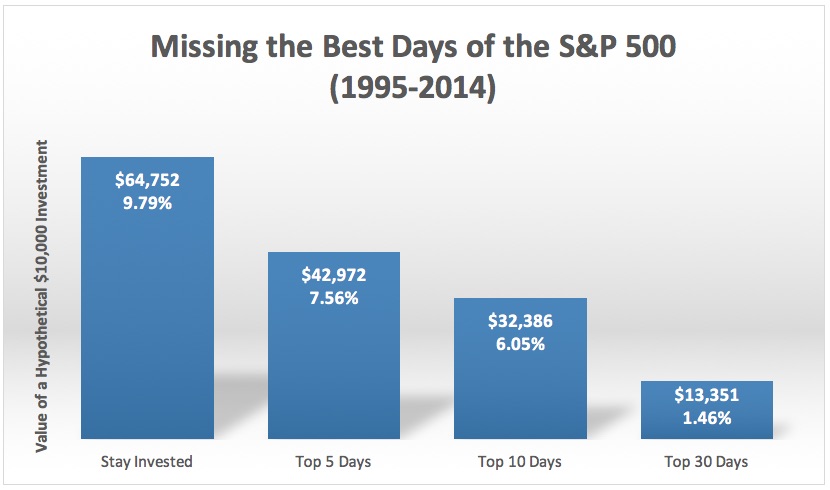Why Market Timing Doesn’t Work

Nathan Weeber | Financial Advisor
Few words characterize today’s financial markets like uncertainty. When overseas economic issues can rob investors of months of gains and speeches by Federal Reserve officials cause markets to flip-flop unpredictably, investors are left wondering what they should do. In an attempt to make major market movements work for their portfolios rather than against, some investors attempt to time the market.
Market timing is the strategy of trying to predict future market movements to time buying and selling decisions. When markets are rallying or pulling back, it can be very tempting to try to seek out the top to sell or the bottom to buy. The problem is that investors usually guess wrong, missing out on the best market days. Can the cost of trying to time the market make a big difference in your returns? You bet it can.
Missing out on the market’s top-performing days can be costly. This chart illustrates how a hypothetical $10,000 investment in the S&P 500 could have been affected by missing the best days during the 20-year period between January 1, 1995 and December 31, 2014.
Source: Standard & Poor’s and Wealth Management Systems. Example based on the hypothetical performance of a $10,000 investment between 1/1/1995 and 12/31/2014. Return represented by total return of the S&P 500, an unmanaged index generally considered to be representative of the U.S. stock market. Past performance is not a guarantee of future results. This is a hypothetical example used for illustrative purposes only and excludes important factors like transaction costs and management fees. You cannot invest directly in an index.
This is a simple example that leaves out some important elements like transaction costs but it serves as a useful illustration of our point. Investors who remained invested for the entire period could have seen their investment grow to $64,752; those who missed just the five top days would have accumulated just $42,972; investors who missed out on the best 30 days would have seen just a 1.46% return during the whole period, much less than they could have gotten on a 20-year Treasury Bond.[1]
Why? Trying to time the market. The average investor misses out on performance in part because their money tends to come in near the top and come out at the bottom. Investors are notoriously bad at picking the right time to enter or exit investments; by the time most investors feel the time is right to invest, many times the investment is at or near its peak. Corrections are a normal part of market cycles and periods of high growth often occur very close to major pullbacks. Investors who sell during the bad times frequently miss out on the best days of performance. If you’re not in the stock when it moves, you may miss out on the whole play.
Bottom line: It’s virtually impossible to accurately find the top or bottom of the market consistently. My experience shows that time in the market is more important than timing the market. Developing a personalized investment strategy and making prudent adjustments when conditions warrant is a much better long-term strategy than making emotional investing decisions. Does that mean that investors have to passively wait out every market, hoping that the next big decline doesn’t take out their life savings? Definitely not.
There’s a big difference between trying to time markets and making strategic shifts to try to avoid major market declines. One of the benefits of active management is that, rather than relying on a single strategy, investors can tap into the experience of multiple money managers who employ different market strategies. Active managers rely on analytical research, economic forecasts, and the human elements of experience and intuition to make critical investment decisions. Now, that’s not to say that even the best managers don’t have bad years. Whatever investment strategy you choose, it’s impossible to perfectly predict future market movements.
Conclusions
Research and long experience have taught me that successful investing requires discipline and the patient execution of a long-term strategy, most especially when it is emotionally difficult; in fact, that is usually the time when opportunities are greatest. I understand that market timing has a tempting simplicity to it – buy low and sell high. However, it’s pretty hard to correctly predict the tops and bottoms of markets and most investors get it wrong. Remember, you don’t have to be the first to the party or the last to leave to have fun – often; just being there when it matters is enough to help you achieve your financial goals.
If you have any questions about the information I’ve presented or want to know how recent economic events may affect your investments, please let me know; I would be happy to discuss your concerns.
Kind Regards,
Nathan Weeber
Footnotes, disclosures, and sources:
* Registered Representatives of and securities offered through Cambridge Investment Research, Inc., a broker dealer, member FINRA/SIPC. Investment Advisor Representatives, Cambridge Investment Research Advisors, Inc., a Registered Investment Advisor. Cambridge and Vision Financial Group are separate companies and not affiliated.
These are the views of Platinum Advisor Marketing Strategies, LLC, and not necessarily those of the named representative, Broker dealer or Investment Advisor, and should not be construed as investment advice. Neither the named representative nor the named Broker dealer or Investment Advisor gives tax or legal advice. All information is believed to be from reliable sources; however, we make no representation as to its completeness or accuracy. Please consult your financial advisor for further information.
We have not independently verified the information available through the following links. The links are provided to you as a matter of interest. We make no claim as to their accuracy or reliability.
Opinions expressed are subject to change without notice and are not intended as investment advice or to predict future performance.
Investing involves risk including the potential loss of principal. No investment strategy can guarantee a profit or protect against loss in periods of declining values.
Past performance does not guarantee future results.
The Standard & Poor’s 500 (S&P 500) is an unmanaged group of securities considered to be representative of the stock market in general.
You cannot invest directly in an index.
Consult your financial professional before making any investment decision.
[1] http://fc.standardandpoors.com/sites/client/generic/axa/axa4/Article.vm?topic=5991&siteContent=8096, http://www.treasury.gov/resource-center/data-chart-center/interest-rates/Pages/TextView.aspx?data=yieldYear&year=1995


 Legacy Life Strategies was born from a desire to help people, particularly as they face key transitional periods in their lives. Through expert counsel in the areas of real estate, elder law, estate and financial planning, mortgage and lending options, and insurance, LLS goes above and beyond to care for you and your legacy.
Legacy Life Strategies was born from a desire to help people, particularly as they face key transitional periods in their lives. Through expert counsel in the areas of real estate, elder law, estate and financial planning, mortgage and lending options, and insurance, LLS goes above and beyond to care for you and your legacy.

0 Comments